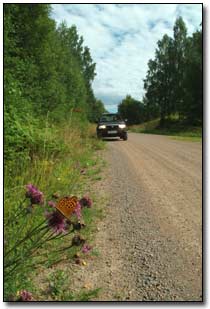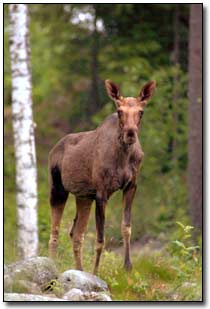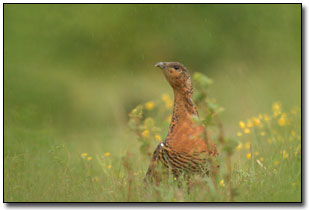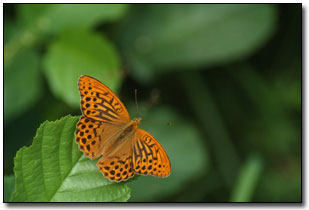|
Drive-in Nature Photography
 A lot of people see nature photography as long hikes in remote wilderness carrying large amounts of equipment, or day after day in a photo-hide in endless waiting for the right situation to occur. Those scenarios are also part of nature photography but it certainly does not have to be that way. Taking the car for a ride is actually an excellent approach to nature photography for the lazy photographer.
A lot of people see nature photography as long hikes in remote wilderness carrying large amounts of equipment, or day after day in a photo-hide in endless waiting for the right situation to occur. Those scenarios are also part of nature photography but it certainly does not have to be that way. Taking the car for a ride is actually an excellent approach to nature photography for the lazy photographer.
Distance Means Nothing
One of the greatest advantages in photography from a car is the ability to quickly cover a large area. For example back in 2003 when I went to Sweden to photograph moose (elk), the only reasonable approach was to do so from a car. During the course of one week my girlfriend and I drove approximately 2000 kilometers (1300 miles) on the deserted gravel roads in a fairly small area hunting for moose with the right background, in the right light, in the right position etc. My knowledge about the area was simply too small to have a fair chance to get a usable image during the brief period I had if I had to walk around or sit in a hide. Driving is no substitute for thorough planning and in-depth background knowledge, but it is a very useful addition.
Road-side Photography Is Easy
 Another advantage in taking the car is that the surrounding areas often are very photo-friendly, which means that when you spot something from the car worth photographing you don't usually have to fight your way through dense shrubs and wet bogs. It is just a matter of getting out of the car, put up the tripod and shoot away (or photographing from inside the car, preserving strength by skipping the first two steps).
Another advantage in taking the car is that the surrounding areas often are very photo-friendly, which means that when you spot something from the car worth photographing you don't usually have to fight your way through dense shrubs and wet bogs. It is just a matter of getting out of the car, put up the tripod and shoot away (or photographing from inside the car, preserving strength by skipping the first two steps).
I have observed, in macro photography of insects in particular, how the subjects are often easier found near the road-side. There are several reasons for this phenomena, the most obvious being that the vegetation in or near the roadside is often cut several times during the summer allowing new fresh plants to emerge, also the road is often raised or lowered compared to the surrounding terrain allowing for a special micro-climate on the slopes (south-facing slopes for example that are warmer than the surroundings). Many animals also enjoy sunbathing on the roads which obviously is not only a good thing
as many are run over but nevertheless offers chances of photographing the sunbathing animals (and the scavengers coming for the remains of those animals that did not make it).
Hide
 Cars are also effective as photographic hides as few animals connect the cars with people. This means that mammals and birds are much easier to approach when sitting in a car than at foot as the animals can not catch the smell of the photographer and can not easily see the photographer in the car either. Covering up the side windows with some fabric is easily done for further endurance that the animals can not see you in the car. An added benefit is that most cars are low enough to let the photographer sit more or less at eye-level with birds and most mammals.
Cars are also effective as photographic hides as few animals connect the cars with people. This means that mammals and birds are much easier to approach when sitting in a car than at foot as the animals can not catch the smell of the photographer and can not easily see the photographer in the car either. Covering up the side windows with some fabric is easily done for further endurance that the animals can not see you in the car. An added benefit is that most cars are low enough to let the photographer sit more or less at eye-level with birds and most mammals.
Weight And Volume
Have you ever had to drag 10-20 kilograms of photographic equipment, water and food when going on a photo-trip? I have tried that many times and having experienced that I consider it a luxury to be able to
just throw everything into the car and drive off. I can even have the stuff laying within easy reach in stead of having to dig through the contents of my bag and pockets when I need something. By taking the car you do not have to consider which items you are able to leave at home in order to have enough room in the bag; if it is something you may need then just bring it along. It doesn't get any easier than
that!
Rain And Snow
 Most photographers using digital equipment knows even better than those using traditional film the fear of having water soak through the equipment. By photographing from the car you do not have to worry about this and you can forget about those nightly nightmares about standing in some remote location with camera equipment worth thousands of dollars which is getting ruined by the rain. Suddenly a heavy shower is no worse than turning up the heat a bit and turning on the radio until the rain stops.
Most photographers using digital equipment knows even better than those using traditional film the fear of having water soak through the equipment. By photographing from the car you do not have to worry about this and you can forget about those nightly nightmares about standing in some remote location with camera equipment worth thousands of dollars which is getting ruined by the rain. Suddenly a heavy shower is no worse than turning up the heat a bit and turning on the radio until the rain stops.
Power
Photography, especially digital photography, needs lots of power. It is easy to fill the bag with nifty gadgets which all requires power to operate such as GPS, external harddrive, laptop PC and anything else that is "absolutely essential" out there. With a transformer keeping all those gadgets freshly charged is suddenly not so difficult even without immediate access to a power socket.
I hope this information is helpful the next time you go out in your car for your Drive-in Nature Photography.
| 
